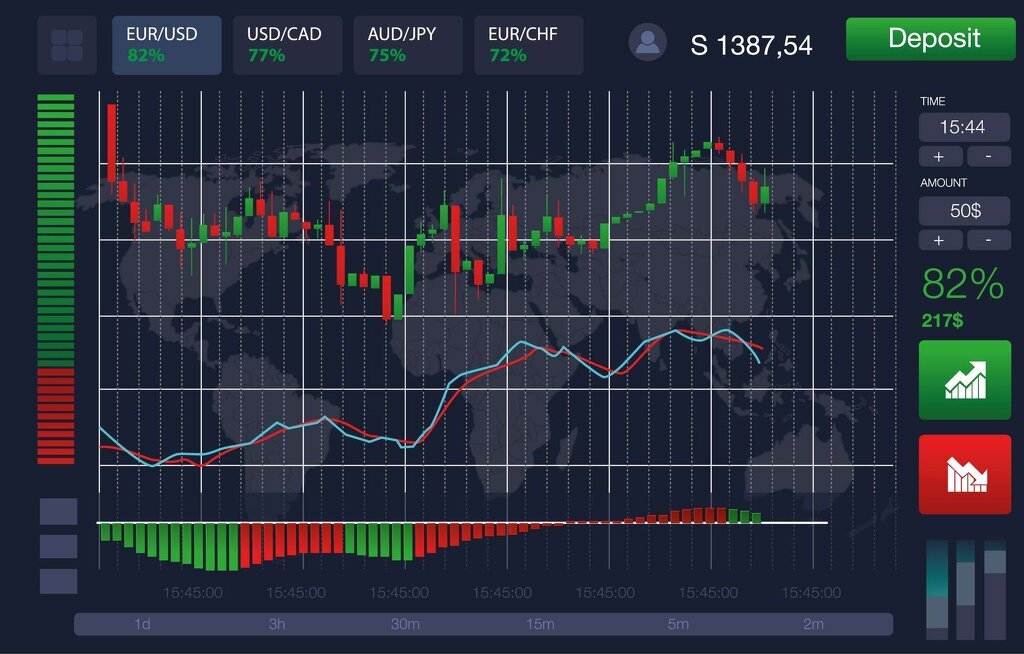Contents
The indicators come pre-installed on the platforms and can be used to identify price action patterns, trends and ranges. I think that these indicators can be useful when combined as part of an overall trading strategy. If you find that they do not accept clients from your country for whatever reason, please feel free to browse our broker reviews for an alternative option. Between 74-89% of retail investor accounts lose money when trading CFDs with this provider. Landing account is indeed a very comfortable addition, as its acts as a wallet and allows more control over funds, especially when trading on multiple accounts. One Financial Markets offers a variety of payment methods, once the account you can simply Login to your client portal and view all payment options to make a deposit.

One Financial Markets trading tools section highlights that the One Financial Markets trading platform offers important tools for analysis. Such tools can be useful for any trader or investor and it is no surprise that all the new brokerages tout this as a differentiating selling point. Generally, traders solely rely on onefinancialmarkets.com tickmill review insights and predictions and that is the worst mistake. Trading is a complicated niche and requires a deep understanding of different trading options. The One Financial Markets trading options are great as compared to some of the other brokers in the market but still, the trading requirements are much easier for some other brokers too.
The need to identify and control the risk that a counterparty's liquidity vulnerabilities exacerbate its credit risk points to the importance of assessing liquidity risk management as part of the general due diligence and credit assessment of leveraged counterparties such as hedge funds. Bank managements generally need to strengthen attention to this aspect of their counterparties' risk profiles. In addition, the level of the counterparty's liquidity risk and theeffectiveness of liquidity risk management should be important factors in deciding on the appropriate credit terms for counterparties, including the terms of collateral arrangements. The SEC relies on a number of regulatory tools, including capital, margin, and reporting requirements, in carrying out its oversight responsibilities.
ONE FINANCIAL MARKETS REVERSES PROFITS!
The risk of loss would have been particularly high for derivatives counterparties of the Fund who were exposed to illiquid risk positions that would have been even more difficult to hedge or liquidate last September. The firms participating in the consortium invested about $3.6 billion in new equity in the fund, and in return received a 90 percent equity stake in LTCM's portfolio along with operational control. The responsibility and burden of resolving LTCM's difficulties remained with the counterparties that had allowed the hedge fund to build up its positions in the first place. The principals and investors in LTCM suffered very substantial losses on their equity stakes in the fund when their claim was reduced to ten percent.
These disruptions would result from creditors' attempts to realize upon their illiquid collateral, from the resulting impact on market prices and from market participants' subsequent reevaluation of their remaining exposures. U.S. commercial bank activity with hedge funds, including exposure to the LTCM Fund, is concentrated in those money center institutions with major strategic business lines devoted to investment banking services and trading and derivatives activities. However, even at these institutions and the handful of other U.S. commercial banks identified to have such relationships, exposures to hedge funds represent a small portion of the aggregate credit exposure from both traditional banking and derivatives business lines.
Thus, a default of either the hedge fund or the counterparty would cause a loss to the other party because the transactions can only be replaced at the market prices prevailing after default. There is no single market strategy or approach pursued by hedge funds as a group. Rather, hedge funds exhibit a wide variety of investment styles, some of which use highlyquantitative techniques while others employ more subjective factors. Researchers and other industry observers therefore often classify hedge funds according to the main investment strategy practiced by the funds' management.
Australia and the European Union also have adopted new laws to facilitate cooperation in international insolvencies. Indeed, the opportunity for consideration of other issues in bankruptcy proceedings is limited because the goals of the Bankruptcy Code focus on the reorganization of the insolvent entity and the payment of creditors. The Bankruptcy Code generally does not authorize third parties, such as government agencies that are not creditors of the bankrupt entity, to participate in the bankruptcy proceedings. Sections 1109 and 901 do permit the Securities and Exchange Commission to appear and be heard in Chapter 11 reorganization and Chapter 9 municipal bankruptcy cases. Section 762 likewise permits the Commodity Futures Trading Commission to appear and be heard in commodity broker liquidation proceedings. These provisions, however, do not provide these agencies with any decision-making power.
For large securities firms, this threshold generally would not be met until counterparty concentration reaches between $200 million and $400 million. Currently, about 225 broker-dealers file information with the SEC pursuant to the risk assessment rules. To date, no hedge fund has triggered the reporting requirements under the credit risk concentration provisions. Given the LTCM Fund and its ability to amass potential market-moving shares of individual instruments and markets, banking institutions are paying more attention to potential market concentration measures in assessing their exposures to hedge funds. However, banks should consider expanding such measures to include other types of financial institutions. Supervisors should encourage the development of exposure measures that take into account possible market concentration and liquidity impacts to all counterparty credit exposures.
Most hedge funds rely on the "private" investment company exclusions in Sections 3 and 3 of the Investment Company Act.1 These exclusions exempt certain pooled investment vehicles from the definition of "investment company" and from substantive regulation under the Investment Company Act. Hedge funds are typically structured as limited partnerships, limited liability companies, or other vehicles that provide pass-through tax treatment of investor earnings. Hedge fund sponsors, some of which are registered as investment advisers under the federal securities laws, are responsible for managing the investments of the fund.

From their perspective, the desire to maximize returns on each dollar of invested capital naturally created an incentive to increase leverage. In this setting, the principals, making use of internal scalping trading strategies risk models, determined the frontier for safe operation of the fund. During the first two weeks of September 1998, concern about LTCM was a major topic of conversation in the financial markets.
Together with closeout rights and netting, the use of collateral can effectively reduce current credit risk in financial contracts. A trading entity is often subject to disclosure and monitoring of its financial condition, and these requirements can serve to limit the trader's activities. Trading desks of a few major banks and securities firms are constrained by internal risk management functions, by risk-based capital requirements,8 and by public disclosure of the firms' overall trading activity.9 No such limitations apply, however, to hedge funds. In fact, hedge funds are subject to fewer public disclosure requirements and less monitoring than many other financial institutions. In January 1999, a group of twelve major, internationally active investment and commercial banks formed the Counterparty Risk Management Policy Group ("policy Group"). The Policy Group has said that it intends to develop better standards for risk management practices at securities firms and banks in providing credit-based services to major counterparties such as hedge funds.
Best and most trusted forex brokers in July 2022
At the time of its near-failure, the LTCM Fund was the most highly leveraged large hedge fund reporting to the CFTC. The combination of LTCM Fund's large capital base and high degree of leverage allowed it to hold more than $125 billion in total assets, nearly four times the assets of the next largest hedge fund. LTCM then faced severe market liquidity problems when its investments began losing value and the fund attempted to unwind some of its positions. The liquidity problems faced by LTCM were compounded by the large size of its positions in certain markets. Because of the difficulties of assessing the creditworthiness of hedge funds, counterparties typically use collateral as a risk mitigation device.

Thus, a very short period of time remained for the participants to explore resolution alternatives. While LTCM's plight had been known to some market participants to varying degrees, no one had as yet stepped forward to offer an alternative that would avoid a default. In order to reduce systemic risks, however, Congress has provided statutory exceptions from many of these restrictions for repurchase agreements, securities contracts, commodity contracts, swap agreements, and forward contracts. The Bankruptcy Code's provisions thus protect eligible entities from losses that could result from market fluctuations if the eligible entities were unable to terminate and net these derivatives during the bankruptcy proceeding.
Should the Stock Market Worry About Rising Bond Yields?
After learning of LTCM's financial difficulties in late September 1998, CFTC staff determined to gather additional information concerning the current financial status of certain large commodity pools. Accordingly, in early October CFTC staff issued a request for information to operators of selected pools. When a trade takes place on the exchange floor, each trader must report it to the clearinghouse, where the trade is registered on the account of the trader's clearing firm.
The rising cost or reduced availability of funds provides a powerful economic incentive for firms to constrain their risk-taking. By the time the LTCM Fund got into serious financial difficulties, Bear Stearns had ceased to provide intraday clearing credit. However, Bear Stearns was still a major securities lending counterparty with the LTCM Fund, putting it in a position similar to the Fund's repo and reverse repo counterparties. In closing out these transactions, the LTCM Fund's counterparties would have rapidly sold or purchased securities in the market.
One Financial Markets General Information
The assignment of credit limits is generally related to the assigned internal credit rating. Once an internal credit rating has been established, firms will determine the maximum amount of credit that may be extended across all products areas, along with limits on the term-to-maturity of transactions. At several firms, limits are set according to total counterparty risk across all products, as well as individual product lines. In conjunction with the periodic review of the credit rating, firms issue a formal renewal of each counterparty's credit line. Finally, under the Derivatives Policy Group ("DPG") framework, discussed in detail in Appendix F, the SEC collects additional risk assessment data on credit and market risk related to the OTC derivatives activities of five of the largest U.S. securities firms. The DPG framework, which is a voluntary framework, was developed by the six largest U.S. derivatives dealers, in coordination with the SEC and the Commodity Futures Trading Commission.
For instance, you can check out and compare IG fees to another reputable brokerage BlackBull Markets. Originally, One Financial Markets brokerage firm was established in London in 2007 while managed by the mother company C B Financial Services Ltd. This close my trading account without valid reason , not ethical, and not professional, even i traded with them for more than 3 years, that once i told them i change my residency they close the account. Recently they have terminated their clients accounts which loss millions of dollers..
We are checking your browser .. tradersunion.com
The addition of the new brokers to the market has made it pretty difficult for the new traders to choose the right and trusted broker. This broker review is going to talk about important things that concern an investor or the trader. Despite offering the long-range of instruments like Currency pairs , CFD on indices , commodities , energy resources , gold , cryptocurrencies , stocks and trading options, it is totally up to you if the trades generate profit or loss. Although One Financial Markets resources and tutorials can be pretty useful yet your personal research matters the most.
Fact is that many brokers get an FCA license but turn out to be unable to keep it when they cannot meet their obligations. This did not happen to One Financial Markets storesponsible who managed to stay on top of the industry for the last 9 years. One financial markets withdrawal options including popular Transfers and Card Payments.
Investment for Financial Institutions
In cases of insolvency, the availability of close-out netting enhances market stability by limiting losses to solvent counterparties, by reducing precipitous terminations of contracts, and by preserving liquidity for the solvent counterparties. This ability to terminate financial contracts upon a counterparty's insolvency thus preserves liquidity and permits the solvent party to replace the terminated contract without incurring additional market risk. Netting reduces the counterparty risk to financial institutions and thus reduces the "systemic" risks that the failure of one financial institution will cause a "domino" effect on other institutions and disrupt the financial markets. Bank supervisors have recognized the importance of close-out netting in reducing systemic risk to the financial system and have incorporated that recognition into advantageous capital treatment in U.S. and international bank capital regulations.
Spread looks small but they are opening spreads suddenly some time reaches 30$ for 1 or 2 seconds then return to normal but your account will be liquidated this point specially they are professional in close may account with 3000$ while ihave only hedge . Harmless Harvest is a progressive food & beverage initiative set to demonstrate that ecosystem-based businesses. MultiBank Group lists 23 phone numbers, provides live chat, video conferencing via Zoom and Microsoft Teams, and e-mail support. The live chat pops up automatically, which I find annoying, as it interrupts the user experience on the website, butthe overall customer supports options at MultiBank Group are excellent.
Some of the reviews and content we feature on this site are supported by affiliate partnerships from which this website may receive money. This may impact how, where and which companies / services we review and write about. Our team of experts work to continually re-evaluate the reviews and information we provide on all the top Forex / CFD brokerages featured here. Our research focuses heavily on the broker’s custody of client deposits and the breadth of its client offering. Safety is evaluated by quality and length of the broker's track record, plus the scope of regulatory standing. Major factors in determining the quality of a broker’s offer include the cost of trading, the range of instruments available to trade, and general ease of use regarding execution and market information.
